EURO 2020 Group B begins with a clash between Belgium and Russia on Saturday. Although the Red Devils looked a lot stronger than the opponents, they should never take the three points as granted. In 2018 FIFA World Cup, Stanislav Cherchesov’s Russia had produced some shockers and achieved their historically best result by entering the quarter-final. They knocked Spain – another strong team out of the tournament years ago. If Roberto Martínez’s troops were not careful enough, they might find themselves in trouble in the first game.
But how exactly could these two teams exploit the weaknesses of each other? This tactical analysis would give some possible tactics of both sides.
Predicted lineups
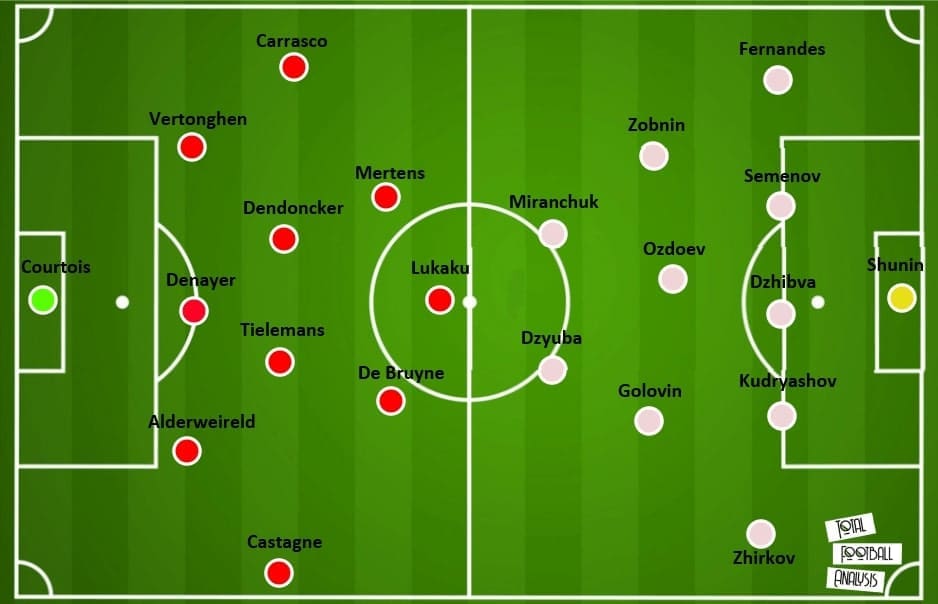
Belgium (3-4-2-1): Thibaut Courtois; Toby Alderweireld, Jason Denayer, Jan Vertonghen; Timothy Castagne, Yannick Carrasco, Leander Dendoncker, Youri Tielemans; Dries Mertens, Kevin De Bruyne, Romelu Lukaku
Martínez had a mature and stable team who could play with different types of formations, but there was no point to change the familiar back three formations. Most players already nailed their starting spots, including the likes of De Bruyne and Lukaku. There might be some undecided names on the team sheet such as the left side, should Carrasco playing at left wing-back and keep Mertens, or starting Nacer Chadli at wing-back to push Carrasco higher? We would know the decision by the time of announcement.
Russia (5-3-2): Anton Shunin; Mario Fernandes, Andrey Semenov, Georgiy Dzhikiya, Fedor Kudryashov, Yuri Zhirkov; Roman Zobnin, Magomed Ozodev, Aleksandr Golovin; Aleksey Miranchuk, Artem Dzyuba
We tipped Russia to play in a back five as this would offer them higher solidarity to cover each vertical zone when defending. Since Belgium had some of the best offensive flairs in the world, all Cherchesov’s side could do was to limit the spaces of the individuals. In front of the back five, it would be ideal to have three midfielders instead of two, which would help to dominate the central areas by numbers. The availability of Kudryashov was still uncertain at the time of writing as he injured himself against Bulgaria earlier, surely Cherchesov would consider other options to replace the 34-year-old defender.
Russia aren’t without a chance to win
Defensively, Belgium had some weak spots that might be exploited by the Russians. Since their wide centre-backs: Alderweireld and Vertonghen were 32 and 34 already, Belgium would not be able to press with a high line throughout the game. More often they would need a midblock to keep the three lines compact and reducing spaces behind the defence.
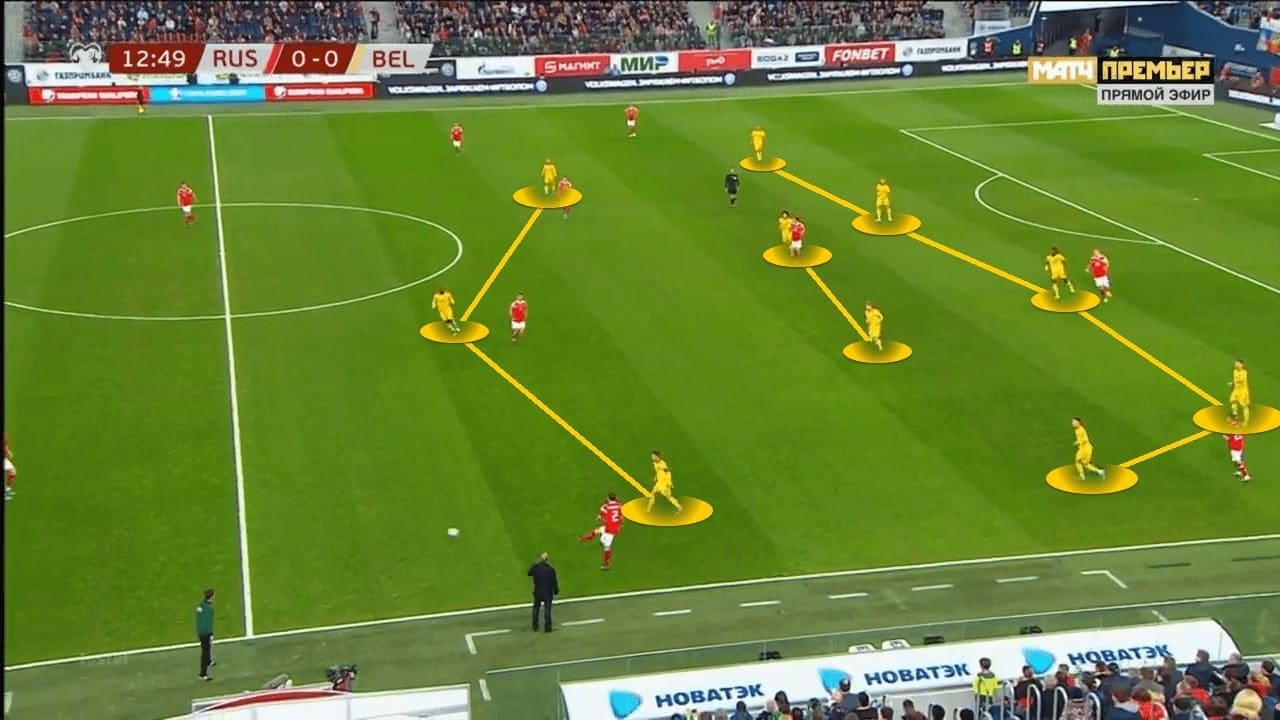
Therefore, Belgium would defend in a 5-2-3 block at the midfield as shown above. They would keep the midfielders together to protect spaces in front of the defence, then using the front three to cover players at the centre. The intention was to dominate the central areas by numbers, leaving some wide spaces open as the wing-backs would step up and press the wide players vertically.
But lacking pressure and intensity on the ball when defending would also let Russia centre-backs play with more spaces. Therefore, the likes of Semenov and Dzhikiya should not give away possession cheaply, and we would expect them to play the first pass well.
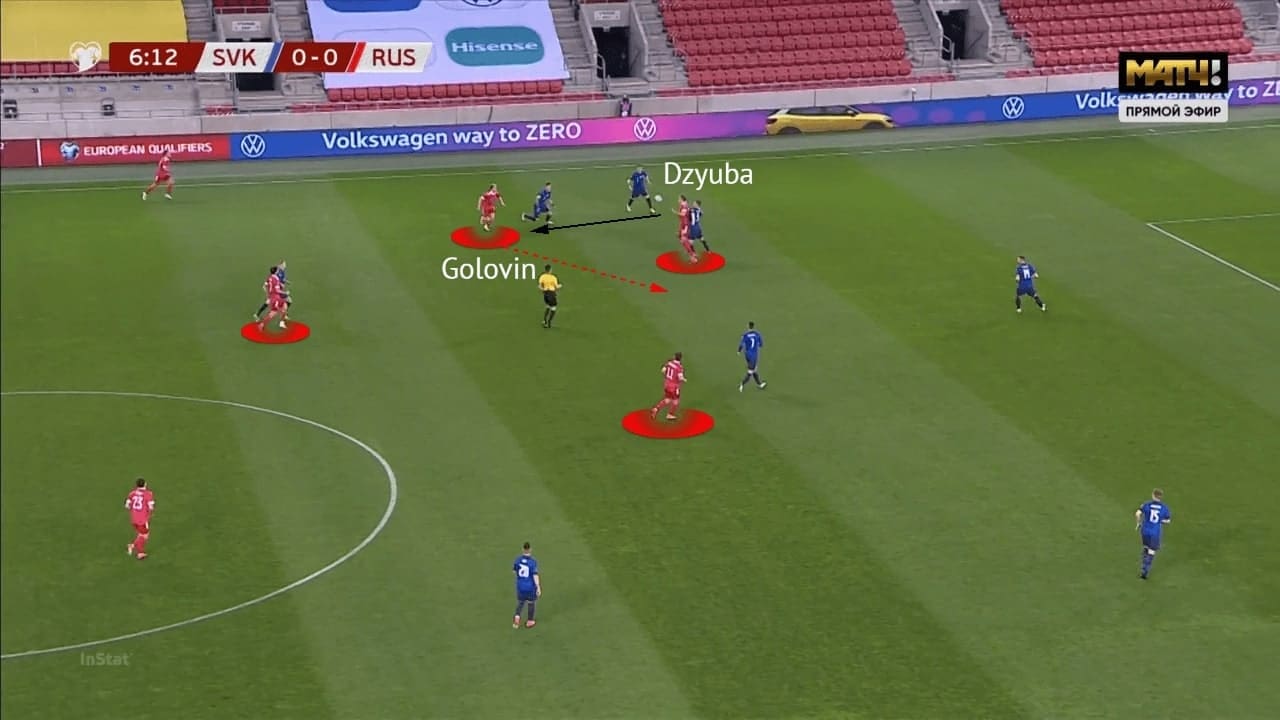
The biggest strength of Russia was the physical superiority of Dzyuba undoubtedly. The 1.96m Zenit centre-forward was the target of long balls, his presence would help Russia breaking the lines by overground passes. Cherchesov liked to put Golovin, the best player in the team around Dzyuba, so the Monaco midfielder could instantly receive the lay-off and drift into critical areas.
The above image shows the second ball distribution of Russia. Dzyuba had the physical strength to chest the ball down even a centre-back was behind, while Golovin quickly moved into spaces to see whether a through ball could release the runners in channels. Against Belgium, Dzyuba inevitably possessed better aerial ability than Denayer, such a mismatch would be a good point to exploit.
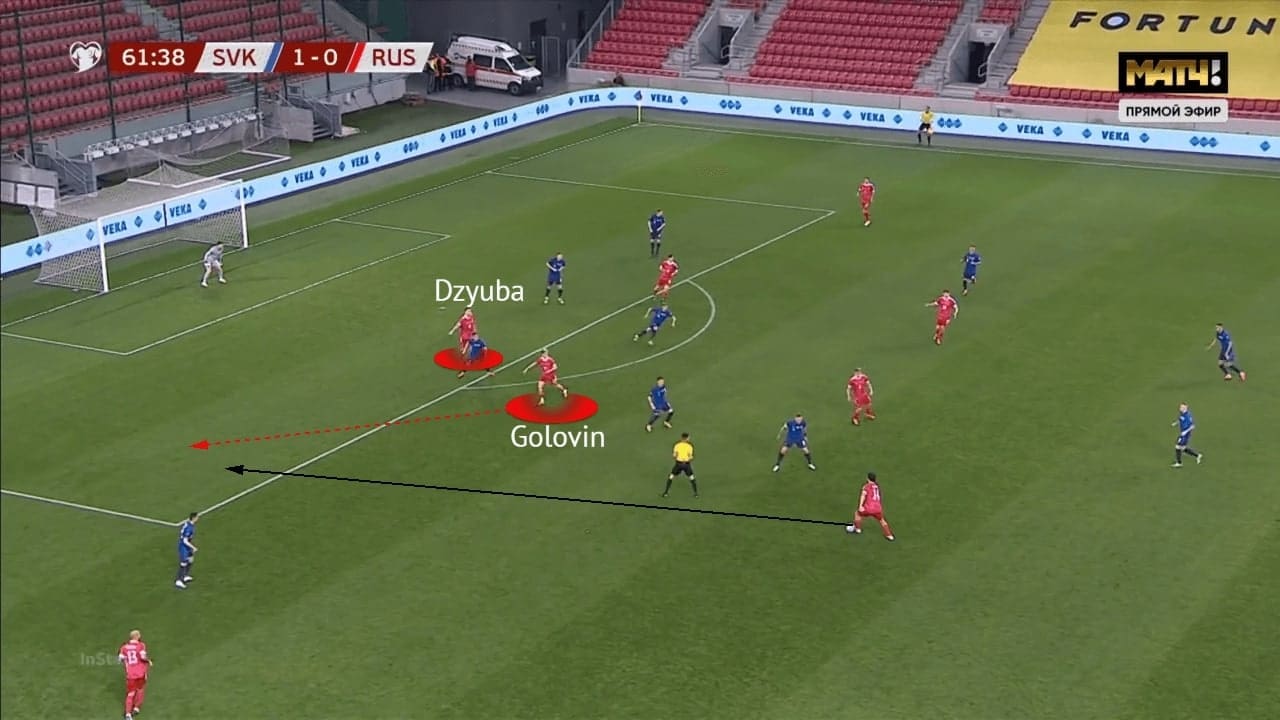
Russia were also strong at crossing as Dzyuba has the physical strength to meet the deliveries. There would also be Russian players lurking around to search for the second ball opportunities and test Courtois.
However, being direct was not the only way to create opportunities. Instead, Russia would also try playing short passes and give the ball to Golovin in this phase, expecting the talented attacker would make something happen. The Monaco midfielder was good at perceiving and exploiting spaces, Belgium would be in trouble if they were not tracking his run.
In this image, Russia successfully penetrated the penalty box by the forward run of Golovin, then, it would be a simple tap in if the ball was fed to Dzyuba. Therefore, the wide centre-backs of Belgium must position themselves correctly and keep these channels as narrow as possible.
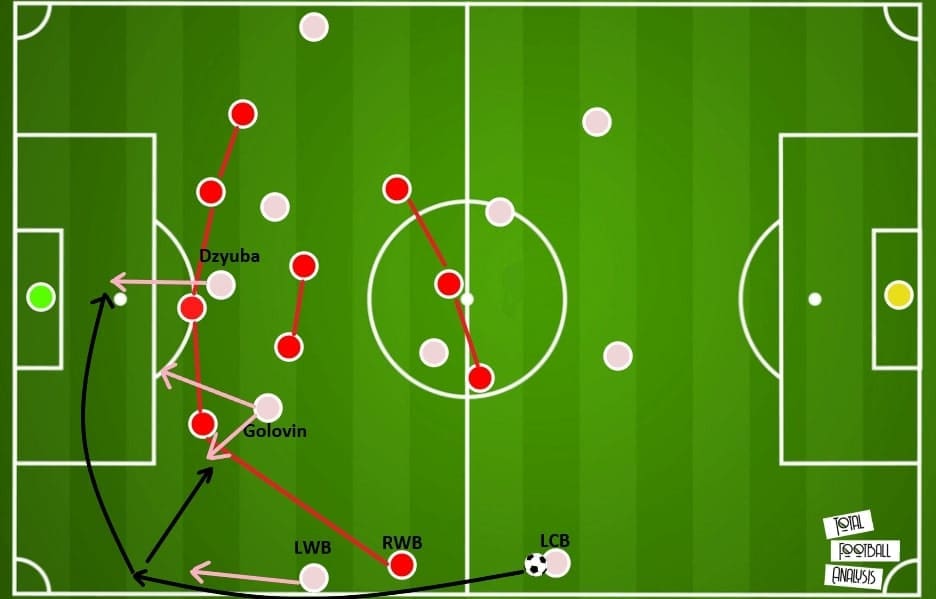
This was a possible way to exploit the defensive structure of Belgium, mostly focusing on taking the wing-back out and exploit spaces behind him. Since Belgium defended in a 5-2-3, their front five were expected to defend spaces at the centre, while the wing-backs should step up to cover wide spaces early.
If Kudryashov played, he would be comfortable operating at the wide zone as he was a natural left-back. Then, the proper wing-back: Zhirkov could push forward to exploit higher spaces. The rest were about space creations and exploitations. Russia should take the Belgium wing-backs out of position to create spaces behind, while Golovin could pin Alderweireld at the half-spaces, freeing up the wide zone. Then, Russia arrived at the final third with dynamism to attack, including crossing to Dzyuba or finding Golovin with short passes.
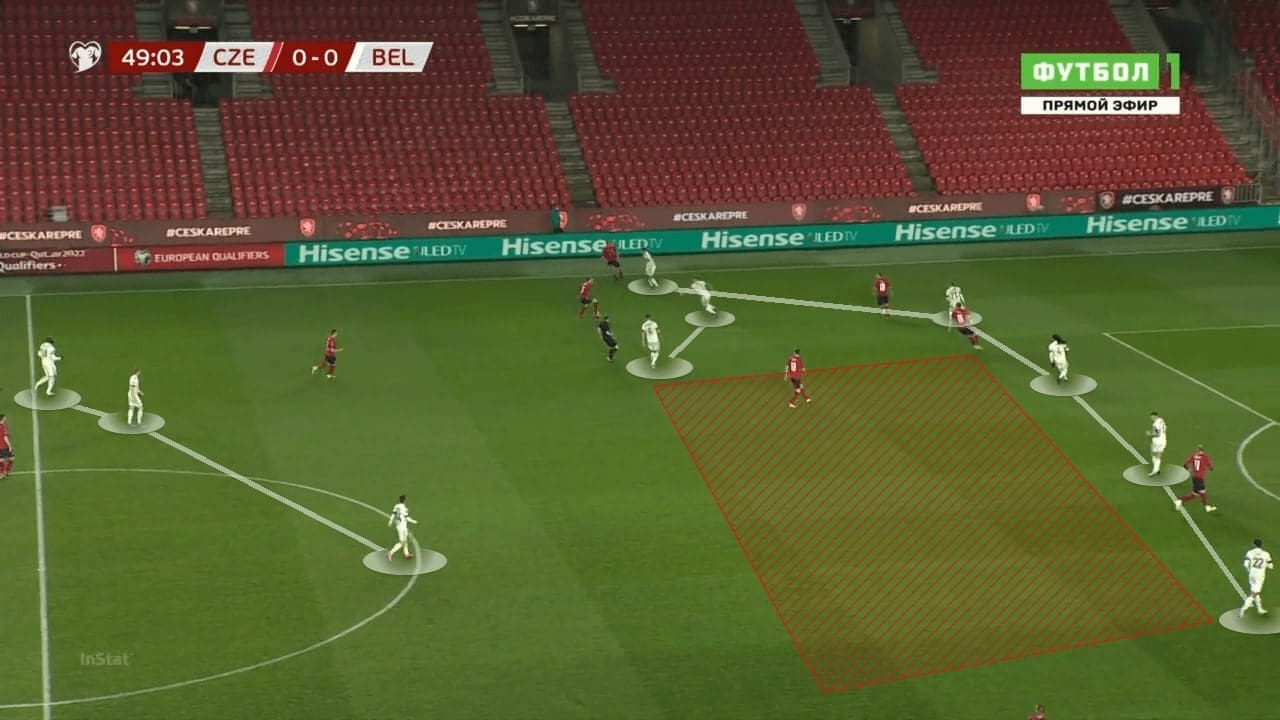
Another weak spot of Belgium was their midfield occupation. Their 5-2-3 defensive shape was exposed at the centre as there were two midfielders only, they would be easily underloaded against formations with three midfielders. Also, when the wingers were defending high, only the Belgian midfielders could help to defend the wide spaces with the wing-backs.
This image was the scenario before Belgium’s conceded goal against the Czech Republic. They vacated the red spaces at the centre when Tielemans and Dendoncker moved wide simultaneously. Given Denayer was not good at defending spaces in front, the oppositions could try long shots from distances when accessing the central spaces.
How can Belgium exploit the opponents?
Despite the above analysis have suggested the strengths of Russia that could catch people by surprises, Belgium should still be the favourites of the match because of possessing player with better qualities.
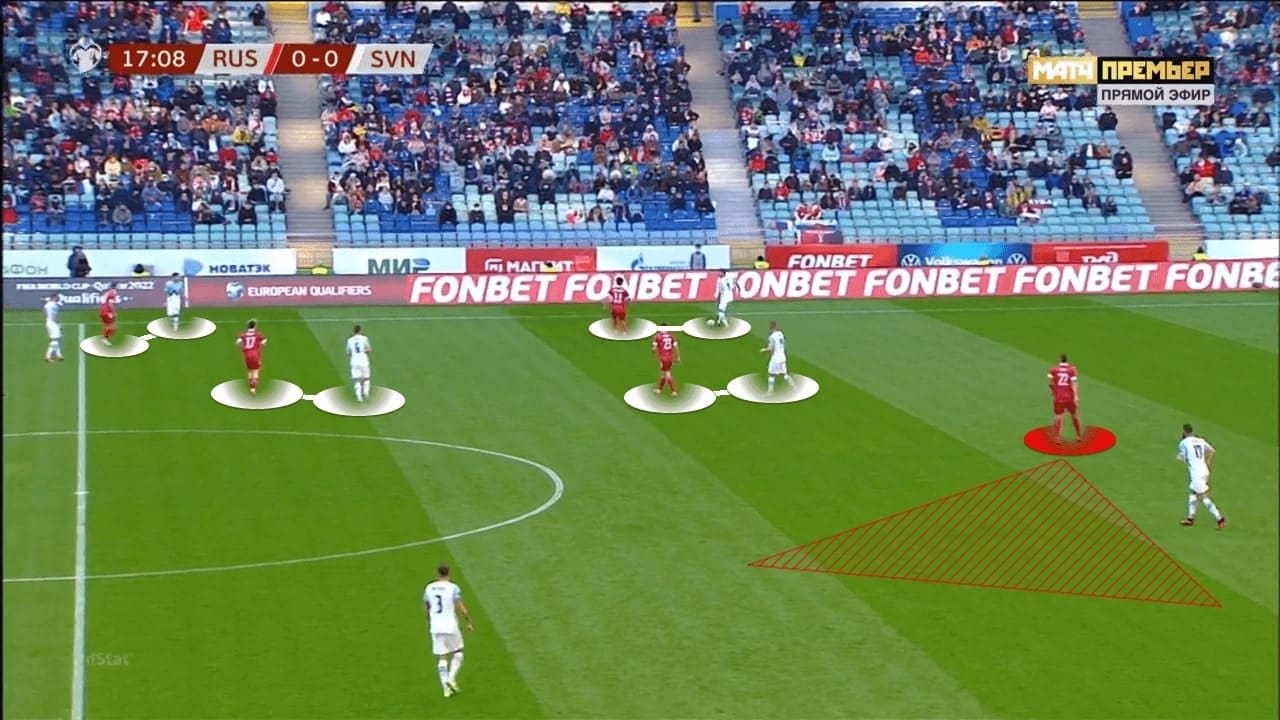
When defending, the Russian would keep a compact shape by using a back five to occupy all vertical zones. The pressing five would be defending in a man-oriented manner, but Ozdoev’s role would be given the freedom to cover spaces.
This image shows the man-oriented defending of Russia. They liked to press at one side by guiding the ball to flanks, then trying to press with the wing-backs and recover the ball there. However, the striker might not be joining the press always as Dzyuba merely stayed to prevent a switch in this situation.
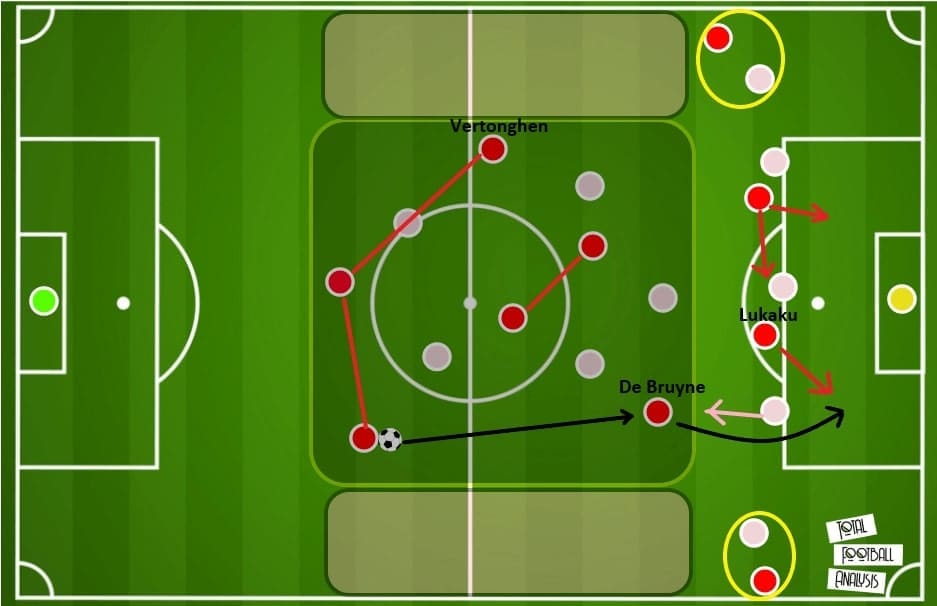
We suggest Martínez would approach the game like the tactics board attached above. They could use a positional structure with concepts such as overloads, pinning, manipulation, and reversed movements.
The 3-2 build-up of Belgium was stable, and they would drop De Bruyne deeper to create an overload at the center of the pitch. Russia defended in a back five, so they only had five players at the midfield, adding De Bruyne could establish a 6v5 in the shaded area. To ensure the numerical advantage was created, Belgium could push the wing-backs high up on the pitch to pin the wing-backs deep, so both wide spaces were vacated for the offensive organization.
Belgium would keep players such as Lukaku and Mertens high to lurk at the defensive line. If any of the centre-backs came out to press De Bruyne, they could be exploited by through balls and face the goalkeeper 1v1. If the centre-backs stayed in the position to control Lukaku, then Belgium had the 6v5.
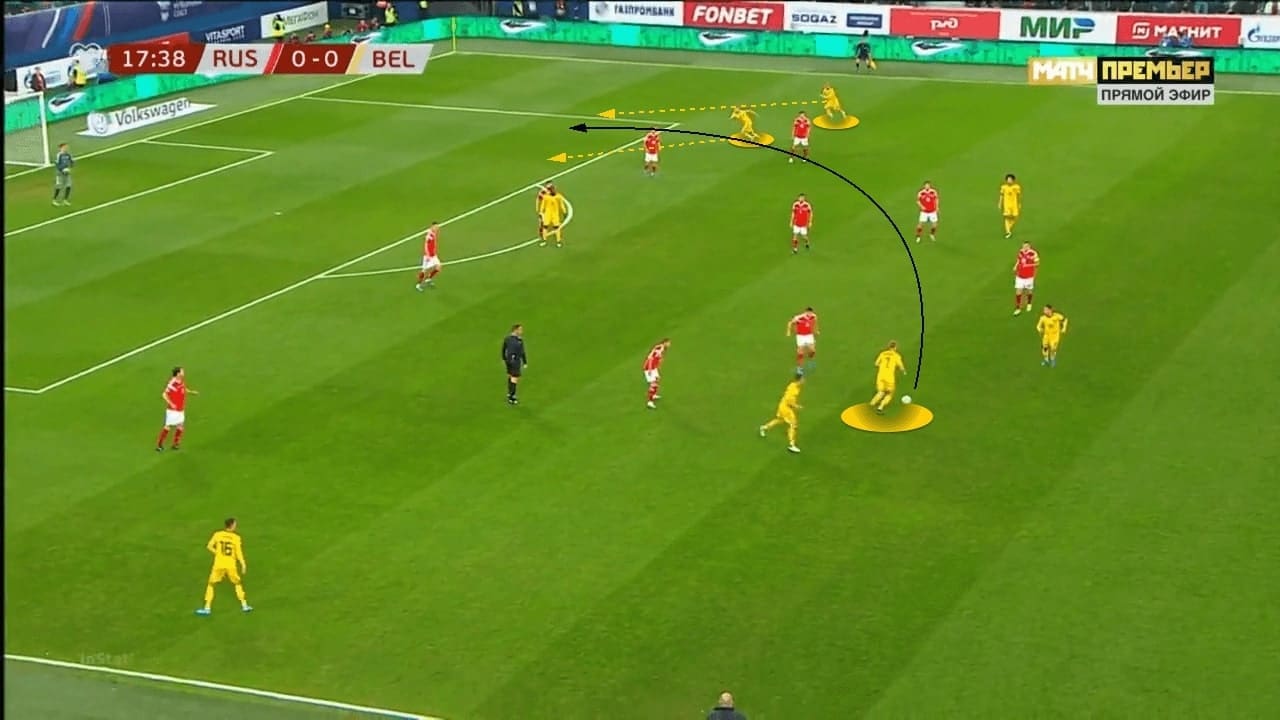
Another advantage of dropping De Bruyne into deeper positions was to fully exercise his passing ability. The Manchester City star could receive the ball more often and play in bigger spaces by dropping deep. In fact, he partnered Dortmund‘s Witsel at the midfield in a 3-4-3 system against Russia in 2019.
The image reflects how De Bruyne could impact the game from deep. To exploit spaces and gaps smartly, Belgium must utilize the wing-backs and attack the channels between defenders. The image shows Martínez’s men were making diagonal runs into the penalty box from the far-side, all they need was the through pass from De Bruyne that send the ball to the blindside of defenders. The opportunities will come.
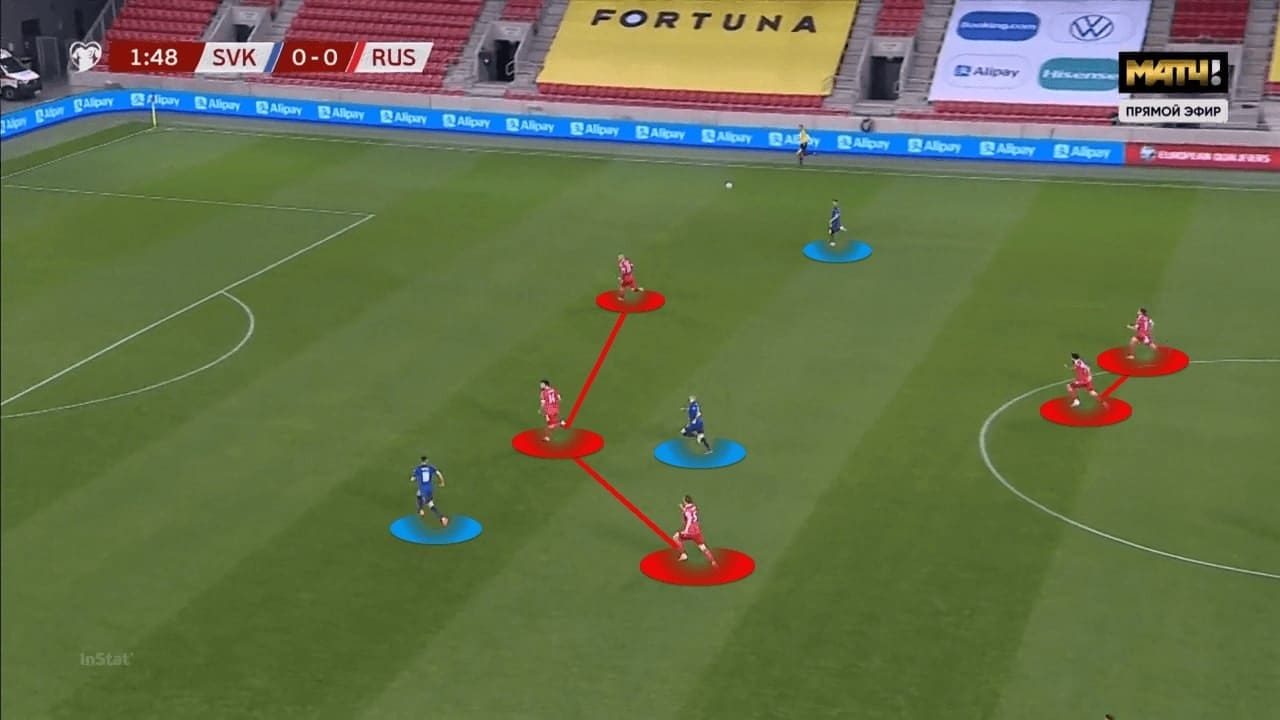
Another source of Belgium goal-scoring opportunities should be the counter-attacks. When Russia were attacking, they pushed both wing-backs high up on the pitch simultaneously. When transitions occurred, spaces behind high wing-backs would be vacated but the centre-backs and midfielders lacked the energy to cover those areas. Belgium just need to release their pacey and skilful players – Lukaku, Carrasco, and Mertens to capitalize on these momentums.
This example shows Russia were defending a transition. Although they had a 3-2 structure at the centre, they gave up too many spaces outside for the oppositions to run. Holding a high line would be a worry of Cherchesov’s side as they would suffer when Belgium countered.
Final remarks
As the analysis suggested, although Belgium had a stronger squad, they were still confronting an extremely tough side that has the qualities to produce surprises. Cherchesov’s men would want to secure point(s) in the first game, they would show the battle spirit to give the opposition a difficult game.





Comments